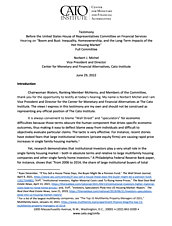Chairwoman Waters, Ranking Member McHenry, and Members of the Committee, thank you for the opportunity to testify at today’s hearing. My name is Norbert Michel and I am Vice President and Director for the Center for Monetary and Financial Alternatives at The Cato Institute. The views I express in this testimony are my own and should not be construed as representing any official position of The Cato Institute.
It is always convenient to blame “Wall Street” and “speculators” for economic difficulties because those terms obscure the human component that drives specific economic outcomes, thus making it easy to deflect blame away from individuals and difficult to objectively evaluate particular claims. The tactic is very effective. For instance, recent stories have stoked fears that large institutional investors (private equity firms) are causing rapid price increases in single family housing markets.
Yet, research demonstrates that institutional investors play a very small role in the single family housing market – both in absolute terms and relative to large multifamily housing companies and other single family home investors. A Philadelphia Federal Reserve Bank paper, for instance, shows that “from 2006 to 2014, the share of large institutional buyers of total purchases increases from virtually zero to 1.47 percent while the share of LLC purchases goes up by 4.04 percentage points.” The authors claim that “despite the rise that began after 2010, in 2014 their shares remained small: The average share of large institutions as buyers was 1.47 percent.” Additional research by the Federal Reserve indicates that institutional investors comprised “1 to 2 percent of all single-family purchases from 2012 to 2014,” while “purchases by other investors accounted for 18 to 19 percent of single-family home purchases during the same period,” and that “buy-to-rent investors owned about 0.14 percent of the housing stock in 2014, whereas corporate investors owned 6 percent and individual investors owned 6 percent.”
Despite the small share, the evidence also suggests that “institutional investors contribute to the improvement of the local housing market by reducing vacancy rates as they shorten the amount of time distressed properties stay in REO [real estate owned foreclosure],” and that “institutional investors help lower local unemployment rates by increasing local construction employment.” Citing other research, the Urban Institute’s Laurie Goodman argues that institutional investors “grew up in 2010–2013 buying distressed properties that no one else would buy and in fact put a floor on the market, so they provided a very, very valuable service and they basically cleaned up the distressed market, a lot of which required repairs.” Goodman also cites evidence that “institutional operators owned just 300,000 single-family units in 2019,” approximately 2 percent of the roughly 15 million one-unit detached single-family rental homes in the United States, and less than 0.5 percent of the total number (80 million) of detached single-family homes in the United States. More recent research by the National Rental Home Council (NRHC) estimates that 0.74 percent of single-family home purchases in the second quarter of 2021 were made by “large investors.” Put differently, the NRHC estimates that 99.26 percent of single-family homes purchased in the second quarter of 2021 “were made by someone, or some entity, other than a large investor.”
In contrast, the federal government is heavily involved in the single-family home market, particularly in ways that increase demand by making it easier to obtain home mortgages. Given that housing markets are consistently supply constrained, there is little doubt that federal housing finance policies contribute greatly to higher home prices. Unfortunately, several new Biden administration policies, as well as multiple proposals being considered in Congress, promise to implement the same types of failed housing policies of the past. Collectively, these policies will further expand government intervention in housing markets at a great cost to millions of Americans, pushing up prices as well as rental rates, wasting taxpayers’ money and making housing less affordable.

This work is licensed under a Creative Commons Attribution-NonCommercial-ShareAlike 4.0 International License.

